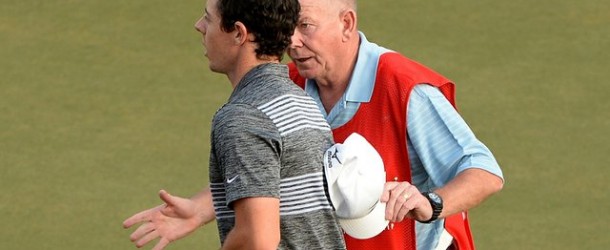In what was shaping up to be a drama free start to the 2014 season, Rory McIlroy just can’t seem to handle prosperity. During his downtime this winter, McIlroy got engaged to his girlfriend, Caroline Wozniaki and thus removing the constant media speculation around the status of their relationship. He spent countless hours working on his Nike equipment, including introducing a new golf ball in 2014. McIlroy was seemingly putting the puzzle pieces in place to return to his former glory on the golf course.
McIlroy’s first milestone was making the cut in Abu Dhabi. Remember it was last year where McIlroy introduced his relationship with Nike and then proceeded to miss the cut in the season’s first event. So when McIlroy made the cut after rounds of 70-67, playing alongside Phil Mickelson who posted 73-70 it looked as if Rory was clearly on his way to a stress free opening for 2014.
No so fast my friend, as the great Lee Corso has coined. In McIlroy’s third round, while taking relief from a cart path, McIlroy violated the rules of golf (Rule 24-2b) when he didn’t take complete relief from the path. Unfortunately for McIlroy, he wasn’t made aware of the rules violation until the 18th green when a playing competitor’s caddie, Dave Renwick, approached him regarding the potential infraction.
The game of golf’s experienced an influx of interesting rules situations over the years with the advent of HD television and the armchair rules official. And now we have “Caddie Gate”.
According to reports out of Abu Dhabi, Renwick was 30 yards away from the drop and couldn’t shout quickly enough before McIlroy hit his shot. But why did Renwick wait until the 18th green to make McIlroy aware of the issue? Renwick apparently thought raising the issue earlier would have detrimentally affected McIlroy’s round and thus felt it was appropriate to not bring it up until he completed his round. I disagree with this approach.
While any player would clearly be disappointed or possibly even upset by having to add two strokes to his score, the player has the right to know exactly where he stands, especially if the violation was a clear cut as this appeared to be.
And what about a Caddie bringing up the rules violation in the first place? Is it a Caddie’s place to be an enforcer of the Rules of Golf?
Caddies definitely have a right, even a responsibility, to know the Rules of Golf. Their most important responsibility regarding the Rules is to make sure their player doesn’t make a Rules mistake. But they also can play a role in protecting the field, the other 120+ golfers in a tournament by making sure the Rules of Golf are followed.
When a Caddie sees a violation, he/she should communicate what he saw to his player and not directly to the other competitor. I realize Dave Renwick is a veteran caddie, but the proper way to handle the situation he was in was to inform his player (Ricardo Gonzalez) what he witnessed as soon as he saw it and then Gonzalez should approach Rory about the situation.
McIlroy turned a 68 into a third round 70 and eventually would lose by a shot to eventual winner Pablo Larrazabal, tying Phil Mickelson at 13-under for the tournament.
Maybe of bigger concern is the fact McIlroy wasn’t aware of the violation in the first place, whereas he could make sure he took complete relief. It’s not exactly an uncommon occurrence in the modern game of golf to find your golf ball on a cart path. As a player, you have the option of playing the golf ball as it lies, or taking relief under Rule 24-2.
Rule 24-2b – If the ball lies through the green, the player must lift the ball and drop it, without penalty, within one club-length of and not nearer thehole than the nearest point of relief. The nearest point of relief must not be in a hazard or on a putting green. When the ball is dropped within one club-length of the nearest point of relief, the ball must first strike a part of the course at a spot that avoids interference by the immovable obstruction and is not in a hazard and not on a putting green.







Comments are closed.